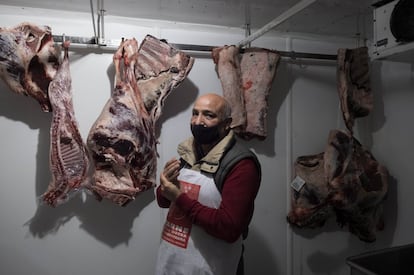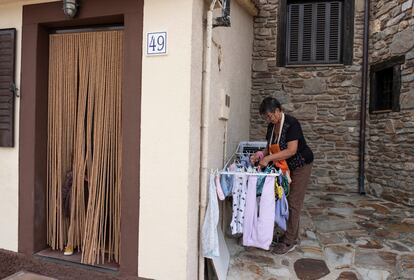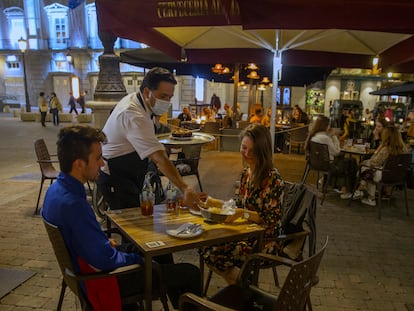The Madrid villages that have remained free of the coronavirus
The region is the worst affected in Europe, but these five municipalities have yet to record a single confirmed case thanks largely to their remote location and the discipline of locals

Madrid is the region worst affected by the coronavirus pandemic in Europe. But there are five municipalities in the region that have remained free of the coronavirus: La Hiruela, Robledillo de la Jara, Navarredonda y San Mamés, Somosierra and Horcajo de la Sierra. They are all small villages in Madrid’s Sierra mountain range, where temperatures can plummet due to the high altitude.
Each has little more than 100 inhabitants, mostly retirees who spend the morning playing cards or taking a walk – a lifestyle that needs little restriction. “I am very comfortable away from the coronavirus, although there is not much to do,” says José Sanz, 75, as he picks apples and tomatoes in his garden in Horcajo de la Sierra. “You can’t get close to people and you have to wear your mask. It’s a shame that it has to be like this, given how wonderful life was,” he adds.
If the Madrid region resembles a left-leaning triangle on the map, Somosierra would be its highest point. Almost 1,500 meters above sea level, the village caught a fleeting glimpse of the virus at the start of the pandemic. “We had a case in March that had all the telltale signs,” says the mayor, Francisco Sanz, who explains that no tests were done to confirm it. And there has been no trace of it since.

News of the case spread through the village like wildfire, terrifying the residents. An ambulance came with two nurses in full personal protective equipment (PPE), an outfit that looks like a beekeeper’s suit. Sanz says that was the only time the virus showed up in Somosierra. The family of the suspected case was told to quarantine, which they did, and days later, the Military Emergency Unit hastily disinfected every corner of the village. Now, eight months later, the coronavirus is just a pandemic they hear about on television.
“I’m not going down to Madrid, there’s no way,” says Yolanda Cerezo, the owner of the only hotel in town and a stop for truck drivers since 1955. The hotel was, until the start of the pandemic, open 24 hours a day, every day of the year except Christmas Eve and New Year’s Day. Now only half the staff is still working. She says that her two children, who are 17 and 16, are virus-free. “And if they tell me that one of their friends from Madrid is coming, I say no,” she adds.
Alfonso Cerezo is Yolanda’s brother and the village butcher. He is a serene man of around 50, who is used to silence and who sells steaks the size of elephant ears – at €17 a kilogram. “Ten minutes on the grill with rock salt,” he explains. “It’s all it needs.” On a good weekend, Alfonso would sell large quantities of meat, but with tourism gone, his sales have more than halved. From €3,000 on Saturdays and Sundays, he now makes next to nothing – the consequence of the economic pandemic, which, unlike the virus itself, has made its presence felt in these parts.

A few days ago, Alfonso got a German Shepherd dog that wags its tail whenever anyone dares to look through the gate. The sight of him prompts Alfonso to explain his theory on why the coronavirus hasn’t hit here. As a young man, he would look after his animals on the mountainside and noticed that the ticks attaching themselves to his cows and dogs, died when they reached Somosierra, killed by the cold, he says, the same cold that keeps the virus at bay.
José Sanz is one of the 147 residents of Horcajo de la Sierra. Since the start of the pandemic, the population has grown by 40 as people with second homes in the village have come to stay on a more permanent basis. No longer is there much coming and going from Madrid, that distant urban silhouette on the horizon that might as well be Mordor, the dark realm in The Lord of the Rings, as far as these mountain residents are concerned.
No one here has been infected but many have lost people they know. Sanz’s 82-year-old brother died in the space of a week last March. Meanwhile, Sanz himself, who suffered a heart attack 22 years ago, feels safer here than in the capital. “There aren’t many people and we are in the middle of the mountains, with plenty of fresh air,” he says. “The virus won’t easily reach us here, but people don’t go out much – it’s clear that a lot of people are very scared.”
The mayor of Horcajo de la Sierra, Adrián Manzanares Uceda, could be Sanz’s grandson. He is 27 and proud that the village is free of the coronavirus, although in May he was shocked by regional government data that showed the village as having the highest incidence of positive cases in the Madrid region – an apparent error that was subsequently corrected.
On the other side of the mountain, the village of Garganta de los Montes was free of Covid-19 until two weeks ago. Back at the start of the pandemic, the mayor, Juan Carlos Carretero, was something of a pioneer, asking bars and rural hotels to shut before this became general policy. He also organized grocery runs for the locals, earning him the nickname “the Amazon Mayor” after the online delivery service. When the lockdown was over, the population increased from 350 to 425. “It will appear in the history books as the urban exodus of 2020,” he says.

During the summer, the population went on to triple and that is when the village got its first positive case. Then came another. The mayor says they don’t know who these cases were but doubts they are still in town. “The problem is that they don’t pass data on to the mayors. I think they should, as long as they comply with data protection laws. No one can keep tabs on an infected person and their contacts better than a mayor.”
Mayors doing the contact tracing of positive cases is not a bad idea. It’s what the mayor of Robledillo de la Jara, Guillermo Crescente García del Moral, did. “Officially we don’t have any cases,” he says.
The village has 70 residents and every week, García makes it his business to keep a check on them, making 52 calls over the course of four hours. None have any symptoms. “These are retired people and very healthy,” he says. “They have their own vegetable gardens, they go for walks, they are very active, and that helps.”
At first, it was difficult to raise awareness about the risks of the virus, but now the residents follow the rules with military precision, careful to keep a distance between one another. “Madrid is very big and there is a lot of interpersonal contact,” says García. “It’s very difficult to ride the Metro and not have someone up close to you. But we don’t have the Metro here. We don’t need one.”
English version by Heather Galloway.
Tu suscripción se está usando en otro dispositivo
¿Quieres añadir otro usuario a tu suscripción?
Si continúas leyendo en este dispositivo, no se podrá leer en el otro.
FlechaTu suscripción se está usando en otro dispositivo y solo puedes acceder a EL PAÍS desde un dispositivo a la vez.
Si quieres compartir tu cuenta, cambia tu suscripción a la modalidad Premium, así podrás añadir otro usuario. Cada uno accederá con su propia cuenta de email, lo que os permitirá personalizar vuestra experiencia en EL PAÍS.
¿Tienes una suscripción de empresa? Accede aquí para contratar más cuentas.
En el caso de no saber quién está usando tu cuenta, te recomendamos cambiar tu contraseña aquí.
Si decides continuar compartiendo tu cuenta, este mensaje se mostrará en tu dispositivo y en el de la otra persona que está usando tu cuenta de forma indefinida, afectando a tu experiencia de lectura. Puedes consultar aquí los términos y condiciones de la suscripción digital.
More information
Últimas noticias
Most viewed
- Oona Chaplin: ‘I told James Cameron that I was living in a treehouse and starting a permaculture project with a friend’
- Sinaloa Cartel war is taking its toll on Los Chapitos
- Reinhard Genzel, Nobel laureate in physics: ‘One-minute videos will never give you the truth’
- Why the price of coffee has skyrocketed: from Brazilian plantations to specialty coffee houses
- Silver prices are going crazy: This is what’s fueling the rally









































